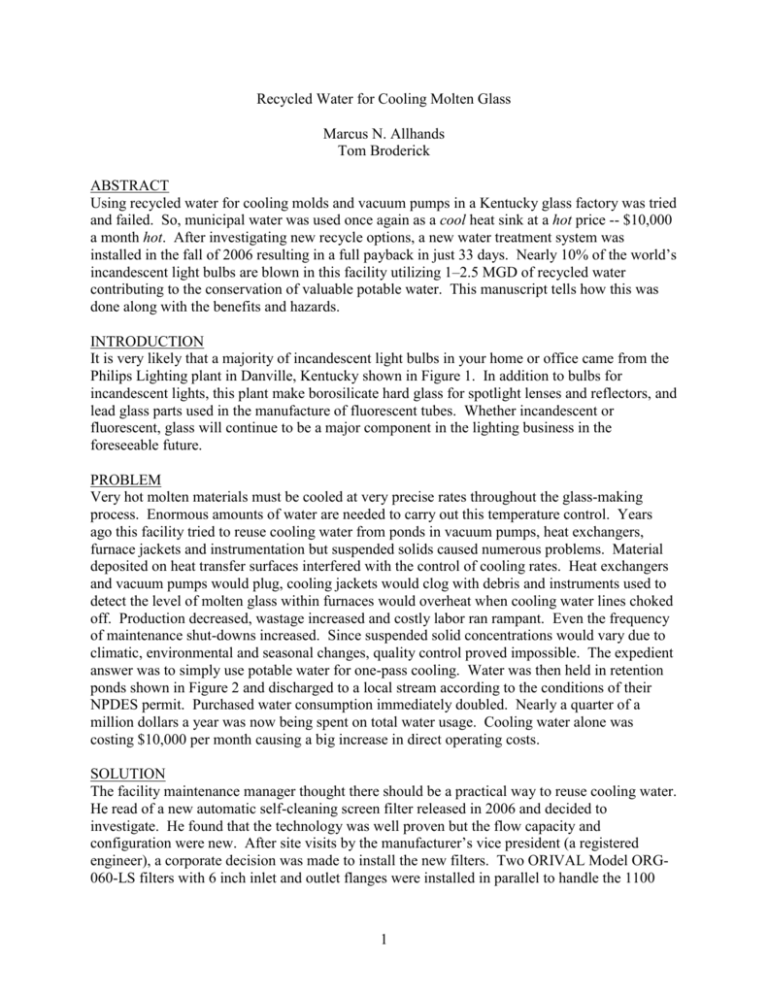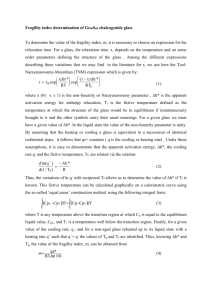Glass_Paper - Processing Magazine
advertisement

Recycled Water for Cooling Molten Glass Marcus N. Allhands Tom Broderick ABSTRACT Using recycled water for cooling molds and vacuum pumps in a Kentucky glass factory was tried and failed. So, municipal water was used once again as a cool heat sink at a hot price -- $10,000 a month hot. After investigating new recycle options, a new water treatment system was installed in the fall of 2006 resulting in a full payback in just 33 days. Nearly 10% of the world’s incandescent light bulbs are blown in this facility utilizing 1–2.5 MGD of recycled water contributing to the conservation of valuable potable water. This manuscript tells how this was done along with the benefits and hazards. INTRODUCTION It is very likely that a majority of incandescent light bulbs in your home or office came from the Philips Lighting plant in Danville, Kentucky shown in Figure 1. In addition to bulbs for incandescent lights, this plant make borosilicate hard glass for spotlight lenses and reflectors, and lead glass parts used in the manufacture of fluorescent tubes. Whether incandescent or fluorescent, glass will continue to be a major component in the lighting business in the foreseeable future. PROBLEM Very hot molten materials must be cooled at very precise rates throughout the glass-making process. Enormous amounts of water are needed to carry out this temperature control. Years ago this facility tried to reuse cooling water from ponds in vacuum pumps, heat exchangers, furnace jackets and instrumentation but suspended solids caused numerous problems. Material deposited on heat transfer surfaces interfered with the control of cooling rates. Heat exchangers and vacuum pumps would plug, cooling jackets would clog with debris and instruments used to detect the level of molten glass within furnaces would overheat when cooling water lines choked off. Production decreased, wastage increased and costly labor ran rampant. Even the frequency of maintenance shut-downs increased. Since suspended solid concentrations would vary due to climatic, environmental and seasonal changes, quality control proved impossible. The expedient answer was to simply use potable water for one-pass cooling. Water was then held in retention ponds shown in Figure 2 and discharged to a local stream according to the conditions of their NPDES permit. Purchased water consumption immediately doubled. Nearly a quarter of a million dollars a year was now being spent on total water usage. Cooling water alone was costing $10,000 per month causing a big increase in direct operating costs. SOLUTION The facility maintenance manager thought there should be a practical way to reuse cooling water. He read of a new automatic self-cleaning screen filter released in 2006 and decided to investigate. He found that the technology was well proven but the flow capacity and configuration were new. After site visits by the manufacturer’s vice president (a registered engineer), a corporate decision was made to install the new filters. Two ORIVAL Model ORG060-LS filters with 6 inch inlet and outlet flanges were installed in parallel to handle the 1100 1 gpm average flow rate. Figure 3 shows the actual installation. Water could now be recycled numerous times through the plant. DISCUSSION Though the pump house seemed large (Figure 4), open space had to he maintained to allow forklifts to enter and pull the two existing vertical turbine pumps for periodic maintenance. Therefore, media tanks would take up too much room. Each filter is equipped with over 466 square inches of effective screen area. The filtration system controller uses either a signal from a pressure differential switch reaching a threshold across the inlet and outlet piping or the termination of an internal timer to initiate a cleaning cycle. The automation and reliability provided by this technology has pleased the maintenance department. The entire cleaning cycle takes about 30 seconds. Each filter has a 1½ inch rinse valve designed to conserve water by minimizing the volume used during each cleaning cycle. The control timer is set to initiate a cleaning cycle every three hours. The time function initiates most cleaning cycles since the differential pressure threshold of 7 psi is seldom reached in three hours. The initial filtration degree of the installed screens was 200 microns or about twice the diameter of a typical human hair. Two subsequent problems occurred following the filtration system installation. First, a chronic oil leak from a specialized piece of equipment in the glass making process began flowing into the floor drains leading into the retention ponds. This equipment was installed in such a way that the leak could not be accessed until a scheduled shut-down occurred. The furnaces must be kept full of molten glass at all times as withdraws are compensated for by new raw materials. An unscheduled shut-down would produce tons of solidified glass throughout the furnaces, flumes and machines. This oil was emulsified in the retention ponds so no free oil could be skimmed from the system. The second problem occurred when the emulsified oil mixed with a fine powdery colloidal material used occasionally in the glass making process. The oil and colloids passed through the screens and began gumming up pipes and instrumentation within the plant. To prevent shut-down conditions, cooling water was once more switched back to municipal supplies. The filter manufacture supplied 50-micron screens to attempt the removal of the finer particles. Eventually the oil leak was fixed and the emulsified oil in the retention ponds dissipated. The system went back onto filtered reuse water with no further mishaps. Payback for the filtration system was a mere thirty-three days. SUMMARY By reusing water, precise product temperature control is maintained, heat exchangers and vacuum pumps are kept free-flowing and instrumentation remains reliable without depending upon potable water supplies. An automatic self-cleaning screen filtration system makes this possible. Even in the resource-rich United States, water is becoming a precious commodity. Proactive companies like Philips Glass are looking for ways to minimize potable water and are therefore reusing water to the maximum extent possible. By reusing 1.6 million gallons of water each day, potable water is made available for 4000 additional households in this Kentucky community. 2 APPENDIX How the ORG Filter Works Dirty water enters the inlet (1) shown in Figure 5, where it goes into the center of the fine screen (2). The water then passes through the fine screen from the inside out and exits the outlet (3). The unwanted solids accumulate on the inner surface of the fine screen, creating a pressure differential. Once the pressure drop reaches a preset level, a rinse cycle is activated by the factory supplied control system by opening the rinse valve (4) to an atmospheric drain. As a result, pressure drops in the hydraulic motor chamber (5) and dirt collector assembly (6). The pressure drop creates a backflush stream at the nozzle openings which are very close to the inner screen surface; this low pressure area sucks the dirt off the screen, similar to a vacuum cleaner. The backwash water is carried through the collector and ejected out of the holes in the hydraulic motor (7). The water being ejected out of the hydraulic motor causes the collector to rotate, similar to a lawn sprinkler. In addition, pressure released from the hydraulic piston (8) causes the collector assembly to slowly move upward. This combination of rotational and linear movements ensures that the entire screen area is cleaned each cycle. The cleaning cycle of the ORG-015-LE and ORG-020-LE takes less than 10 seconds while the larger filter models take a few seconds more to clean. 3 Figure 1. Philips Glass facility in Danville, KY. Figure 2. One of two retention ponds. 4 Figure 3. Two ORIVAL Model ORG-060-LS filters. Figure 4. Pump house. 5 8 Figure 5. Transparent view of ORG filter. 6 AUTHORS Dr. Marcus N. Allhands, PE Vice President of Business Development Orival, Inc. 213 S. Van Brunt Street Englewood, NJ 07631 (551) 206-8526 cellular (765) 987-7843 fax ma@orival.com Tom Broderick Maintenance Manager Philips Lighting Company 320 Vaksdahl Avenue Danville, KY 40422 (859) 238-9218 office (859) 238-9290 fax tom.broderick@philips.com 7






